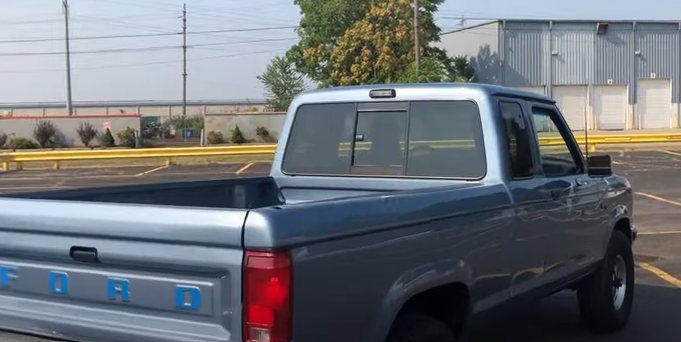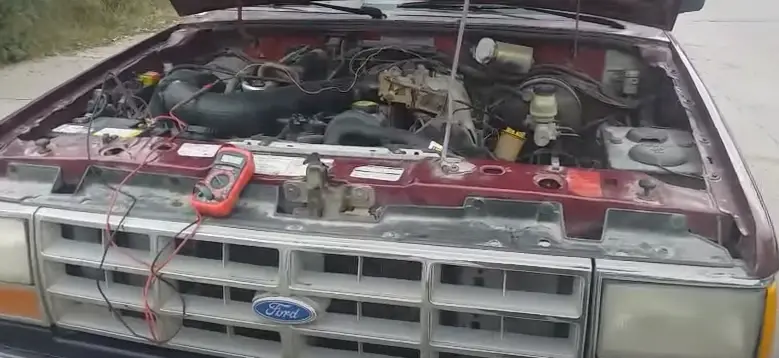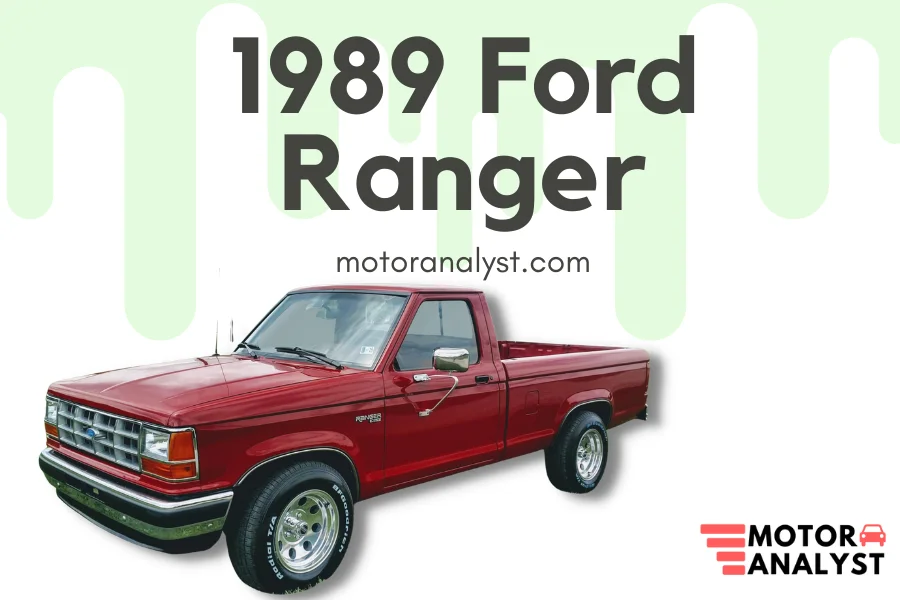The 1989 Ford Ranger, a series of compact trucks introduced in 1989 to succeed the Ford Courier, which was derived from Mazda, quickly rose to the top of the compact truck market. The first-generation Ranger was released in 1982 for the 1983 model year, and in 1989 it got a significant mid-cycle update. The 1989 launch of the twin-spark-plug Pinto engine saw its continued use up until 2001.
Rear-wheel anti-lock restraints were made standard on Mazda M5OD-R1 transmissions for the 1989 Ford Ranger model year. The Ranger’s internal aesthetics and outward aerodynamics were both enhanced with the 1989 redesign. A variety of synchronous, V6, and diesel-powered was offered in the first-generation Ford Ranger vehicles.
1989 Ford Ranger: Appearance Specs.

The 1989 Ford Ranger received new front flares, a reworked hood, and an updated grille and headlight assembly. A set of self-closing headlights and a bigger but much more streamlined frontal bumper was also new. The majority of these changes, according to Ford, were made to improve the Ranger’s aerodynamic efficiency.
| Model Trim | Length | Width | Height | Wheelbase | Curb Weight |
|---|---|---|---|---|---|
| Short Bed | 176.5 in | 66.8 in | 63.8 in | 107.9 in | 3,128 lbs. |
| Long Bed | 188.5 in | 66.8 in | 63.8 in | 113.9 in | 3,168 lbs. |
| SuperCab | 193.6 in | 66.8 in | 64.3 in | 125 in | 3,464 lbs. |
The Ranger’s upholstery had a significant makeover as well, getting new interior trim, seats, and a dashboard redesign that included a glove box on the passenger’s side. Additionally, a brand-new instrument cluster was unveiled, and customers ultimately showed them to be fond of it. Considering the version and bed size, the Ford Ranger’s specifications change.
1989 Ford Ranger: Color Options
The exterior color range available for 1989 Ford Ranger and its various bed size trims are as follows:
Black, Medium Cabernet Red, Graphite Metallic, Light Sandalwood Pearl Metallic, Light Crystal Blue Pearl Metallic, Twilight Blue Pearl Metallic, Silver Metallic, Medium Scarlet, Hunter Green Pearl Metallic, Pastel Sandalwood, Sandalwood Metallic, White and Medium Titanium (matt) Metallic
1989 Ford Ranger: Engine Options and Performance
A variety of inline-four, V6, and diesel engines were offered with the first-generation Ford Ranger trucks. The 1989 launch of the dual Pinto engine which saw its continued use up until 2001.
Customers could choose between the 1989 Ford Ranger’s standard 2.3L I4 engine and an additional 2.9L V6 engine. The earlier of these engines had a maximum output of 133 lb.-ft of torque at 2,600 RPM and 100 HP at 4,600 RPM. The latter produced 170 lb.-ft of torque at 2,600 RPM and 140 HP at 4,600 RPM despite only being offered in SuperCab vehicles.
| 2.3L Inline-4 Engine | 2.6L V6 Engine |
|---|---|
| 100hp @ 4600 rpm | 140hp @ 4600 rpm |
| 133 lb.-ft @ 2600 rpm | 170 lb.-ft @ 2600 rpm |
1989 Ford Ranger XLT 4×4
On all 6-cylinder 4×4 Rangers, including the gasoline-powered V6 Ranger Raptor, the comprehensive 4×4 system is a standard feature. Drivers can select between traditional two-wheel drive (rear wheels), 4×4 Auto, locked 4×4 high range, and locked 4×4 low range using the system. Whenever you’re driving through less-than-ideal terrain and temperature fluctuations, a 4WD system can offer a better and more controllable experience when relative to 2WD as well as other drivetrain alternatives.
In pickup trucks and SUVs, the 4WD system is what you will commonly encounter. Because a 4WD system requires more elements than a 2WD system, driving in 4WD consumes more petrol than driving in 2WD. More parts require more gasoline to operate the drivetrain, which results in higher gas usage.
1989 Ford Ranger: Automatic Transmission
The Mazda M5OD-R1 transmission was introduced as the primary transmission for the 1989 model year. The front-engine Ford Ranger pickup trucks have either back-wheel drive or 4-wheel drive. The front-engine However, rear-wheel anti-lock brakes were made a benchmark for the 1989 model year. Regardless of the engine used, the 1989 Ford Ranger could be equipped with either a 4-speed automatic or a 5-speed manual transmission.
1989 Ford Ranger: Towing Capacity
According to the motor, gearbox, 2WD vs. 4WD, axle ratio, wheelbase, and whether it was a Standard Cab or Super Cab, the 1989 Ford Ranger could pull between 1,100 lbs. and 5,600 lbs. Otherwise, you can check your label inside of the doorway latch border of the driver’s door to determine the towing capacity of your exact 1989 Ranger.
1989 Ford Ranger: Fuel Economy
The 1989 Ford Ranger was quite impressive by contemporary standards, but it wasn’t precisely as fuel-efficient as many people had hoped. Although the model’s actual fuel tank capacity is uncertain, it can be inferred based on several other criteria. According to its horsepower, engine specifications, and towing capacity, it is regarded as 16.5 Gallons.
The RWD Ranger had a manual gearbox and was EPA-rated at 21 mpg in the city and 25 mpg on the highway in its base configuration (standard cab/short bed). Those choosing the automatic transmission may anticipate decreasing these figures to 18/22 MPG.
1989 Ford Ranger: Door Panels
These hood latches have a fabric grain patterned finish and are made from strong ABS plastic. The door panels are available in pairs and have padded armrests and an interior window beltline. They are straightforward to install. However, they come in different color ranges from black, slate gray, dark gray, medium gray, taupe gray, light gray, dark blue, dark brown, medium brown, and light brin to neutral.
A door frame replacement can cost more or less depending on the manufacturer, quality, and amount. A set of 2 often costs between $100 and $300. Additional Labor costs could be added if a professional is appointed for the replacement.
1989 Ford Ranger: Dashboard Cover
Dash covers have a leather-like grain pattern and are manufactured from thick, resilient ABS plastic. These sturdy covers won’t fracture in extremely hot or cold climates and are simple to install over your current dash without needing additional tools. They come in various colors, but they may also be refinished to precisely match your car’s upholstery.
The color range available are: black, slate gray, dark gray, medium gray, taupe gray, light gray, dark green, dark blue, light blue, dark brown, medium brown, light brin, and neutral.
1989 Ford Ranger: Alternator

Your Ranger’s alternator’s purpose is to produce electricity when the vehicle moves. Without the aid of an alternator, the battery has enough energy to start the engine. A damaged alternator might render your Ford Ranger immobile even without electricity.
When changing an alternator, it is typically a reasonably priced replacement. The cost of the job is primarily due to the labor. The following are the most typical signs of a damaged alternator in a Ford Ranger:
- Electric Accessory Problems
- Dimmer Headlights
- Obnoxious bearing sounds
- Stalling Engine
- Dead Battery
1989 Ford Ranger: AC Compressor
The thermal processes that distribute cooled and chilled air throughout your vehicle are carried out by AC compressors. It is the part that circulates refrigerant throughout the appliance, enabling it to generate cool air. You won’t have any cold air if your compressor is broken because the other components will lack a critical component.
Inverter tripping can frequently result in blown fuses. Burnt wire or defective engine overload regulators are two more causes of compressor issues. You might encounter a few of the following symptoms if your compressor isn’t working properly:
- Your air conditioner is snarling, screeching, or clattering
- Your AC Has Stopped Blowing Cold Air
- Reduced Airflow
- You Have Trouble Starting Your Air Conditioning
- Reduced Airflow
1989 Ford Ranger Upgrade
Wheels
Installing a new set of tires is one of the Ford Ranger’s least frequent customizations. It’s not just about looks, even if aftermarket wheels always appear much superior than OEMs.
Grills
Switching out the stock, unattractive front grill for a Ford Ranger, the Raptor grill is one of the Ranger’s most straightforward, most affordable, and most effective improvements. These grills, which are among our best-selling products, have a sporty mesh-grille style that closely resembles that of the larger, more powerful F-150 Raptor.
Tires
The advantages of arch kit modifications are instantly apparent: larger arches allow for the installation of wheels and tires with broader, larger diameters.
Front Winch
Winches are necessary for drawing down items like completely fallen trees as well as for hauling other automobiles out of similar situations when they become stuck. The pulling capability can be as low as a few 100 kilograms or as much as 10 tons. Obviously, the price will vary based on how much towing force you require.
City Bars
A-bars, often referred to as towing guards, bump bars, or bull bars, are a very common choice for pickup vehicle owners. In addition to being simply cool, they add a little protection and toughness to the front end of your truck. You can choose the less noticeable city bar, also known as a lower bar, if you want to improve the appearance of your vehicle but don’t want to go all-out with a full A-bar.
Tailgate Damper
In our humble view, a tailgate damper is unquestionably doubted one of the most valuable automotive adjustments you can perform to a Ford pickup truck. Once you’ve had one installed, you won’t be able to survive without one ever again. These clever and useful dampers guarantee that the tailgate is lowered safely and steadily by preventing it from swinging open.
1989 Ford Ranger: Review and Reliability
The 1984 Ford Ranger was one of the most sought-after Ford models thanks to its exceptional performance. Most people have given it an average rating of 4.2 out of 5. Given its cargo space, it is a practical vehicle for small families and even for transportation services.
Reviews on other factors and specifications of the model is mentioned below.
| Comfort | 3.9/5 |
| Performance | 3.9/5 |
| Exterior Styling | 4.4/5 |
| Interior Décor | 4.0/5 |
| Value of Money | 4.9/5 |
| Reliability | 4.3/5 |
1989 Ford Ranger: Trims and Price
| TRIMS | PRICES |
|---|---|
| GT | $14,502–$15,015 |
| S | $8,493–$12,221 |
| STD | $9,845–$14,058 |
| STX | $12,917–$15,903 |
| XLT | $11,492–$14,005 |
FAQs on the 1989 Ford Ranger
What is the ECM location for 1989 Ford Ranger?
On the relay block, on the right front bumper panel, is the 1989 Ford Ranger ECM relay.
Where is the inertia switch located in 1989 Ford Ranger?
Just on the left edge of the car, in front of the main door pillar and beneath the fascia, is where you’ll find the inertia switch. The operator can recalibrate the switch thanks to a knuckle accessibility hole in the molding.
What is the location of OBD control in the 1989 Ford Ranger?
The OBD controls are found near the pedals on the driver’s side of the vehicle.
Concluding Remarks
As a result, it’s challenging to take your eyes off the 1989 Ford Ranger for its beautiful exterior appeal. The inside design is subpar, but the amenities and parameters make up for it. Therefore, these first-generation Ford Rangers offer not only gorgeous aesthetics but also additional cargo room for a comfortable trip.
